A major part of Balance of Payment is the Current Account Balance and throughout 2014 Euro area Current Account Balances accumulated a significant surplus as seen in the chart below.
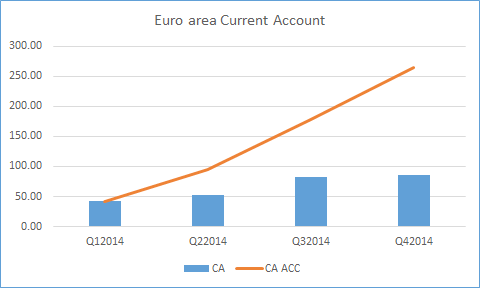
From the ECB’s monthly statistics we also receive details for Direct Investments and Portfolio Investments, showing the following development throughout 2014:
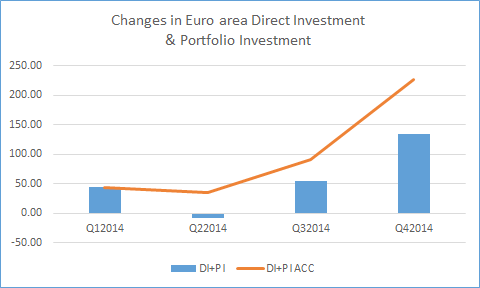
If we put the corporate sectors together with investment sectors, their net purchases of euros throughout 2014 amounted to almost € 500 billion.
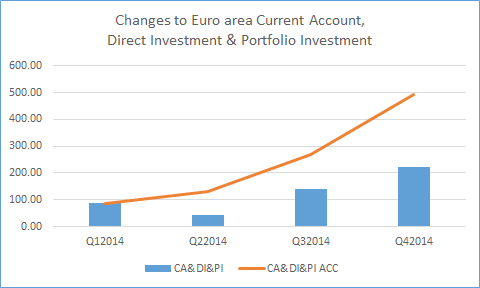
This represented a massive support for the euro with those sectors being net buyers of euros to the average amount of € 2 billion per day.
What some bought, others must have sold and earlier this month we got the IMF report on central bank members’ holding of different currencies. This is quarterly statistics and throughout 2014 central banks had trimmed their assets in euros as follows:
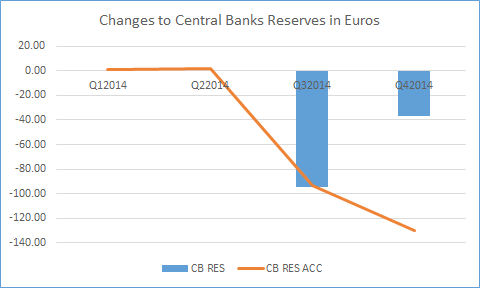
This leaves us with a balance of what “Others” must have sold throughout 2014, illustrated as follows:
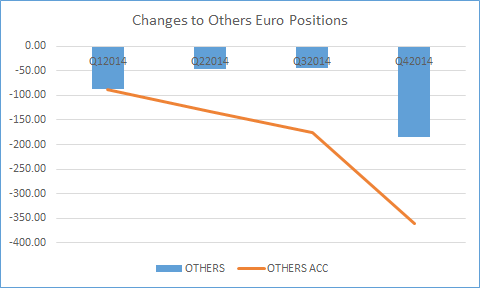
Now – others can be several sources – but they are corporate sectors, classic investors or central banks – as illustrated above.
Adjusted for some “errors” or “adjustments” which are always part of the statistics, I claim that the bulk of “Others” are short-term, speculative positions in euros who have sold themselves down almost € 360 billion throughout 2014. They might not be this amount short, should they be long at the start of the year but the amount should illustrate the change to their overall euro position.
For the first three months of this year, current account balances have been in line with those seen throughout 2014. Direct Investments and Portfolio Investments are a bit down over the three-month period and for central banks’ reserves we do not have statistics yet. But from the figures we do know, the positions three months into this year should not be materially changed from those at the end of last year.
Now to the really interesting part.
There are reasons to believe that current account surpluses will be to the level of those seen last year. If so – that would mean net purchases of € 250+ billion from corporate sectors this year.
Investment portfolios might sell themselves further down – especially money market funds – should the low interest rate scenario continue. If they do, they will supply euros to corporate sectors.
What central banks will do in terms of trimming their euro assets is an open question – but given the size of what they did last year, I would guess there is a smaller amount to be done this year.
Let’s further assume Euro area inflation will pick up from both the low interest rate scenario and the low level of the euro and let’s assume Euro area growth will do the same. We have seen the first signals to this already.
Should such improved figures cause investment portfolios and central banks to stop trimming their euro exposure, we could be left with short-term speculative portfolios as the only source for corporate sectors to get their euros from. Such portfolios are classically vulnerable to most changes to data and especially to price movements.
Given the sizeable change such portfolios went through throughout 2014 and the rather predictable net amount corporate sectors will buy this year, the euro could be in for a significant appreciation in its value by the time the Euro area data start seeing the benefit of what the ECB is doing.
On top of the € 250 billion corporate sectors will buy, should those having sold the € 360 billion last year also start buying euros back, then the Fed might be the only one who could help them out. Without higher USD interest rates, I would think the position setup in the market - as illustrated above – could well take EURUSD back to 1.25-1.35 throughout the year.
It would be a surprise to man...
Recommended Content
Editors’ Picks
EUR/USD clings to daily gains above 1.0650

EUR/USD gained traction and turned positive on the day above 1.0650. The improvement seen in risk mood following the earlier flight to safety weighs on the US Dollar ahead of the weekend and helps the pair push higher.
GBP/USD recovers toward 1.2450 after UK Retail Sales data

GBP/USD reversed its direction and advanced to the 1.2450 area after touching a fresh multi-month low below 1.2400 in the Asian session. The positive shift seen in risk mood on easing fears over a deepening Iran-Israel conflict supports the pair.
Gold holds steady at around $2,380 following earlier spike

Gold stabilized near $2,380 after spiking above $2,400 with the immediate reaction to reports of Israel striking Iran. Meanwhile, the pullback seen in the US Treasury bond yields helps XAU/USD hold its ground.
Bitcoin Weekly Forecast: BTC post-halving rally could be partially priced in Premium

Bitcoin price shows no signs of directional bias while it holds above $60,000. The fourth BTC halving is partially priced in, according to Deutsche Bank’s research.
Week ahead – US GDP and BoJ decision on top of next week’s agenda

US GDP, core PCE and PMIs the next tests for the Dollar. Investors await BoJ for guidance about next rate hike. EU and UK PMIs, as well as Australian CPIs also on tap.